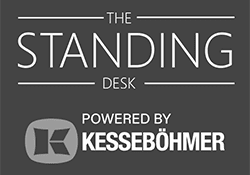With the rate that workplaces are adopting standing desks, it makes sense that one of the hottest ergonomic questions of the moment is “how high should a standing desk be?” After all, proper adjustment is crucial to getting the most out of a standing desk. You can get an approximation of the right height based on our table of standing desk heights, but some fine-tuning will be necessary, and we can explain why.
Variables for Standing Desk Height
The field of ergonomics has been around since the industrial revolution, it really entered the office in the 80s when computer desk work became the norm. Standard fixed desk heights are based on the 1988 Anthropometric Survey of United States Army Personnel, which uses an average of male and female anthropometric dimensions. Although standing desks are newer on the scene, ergonomists have ANSI/BIFMA research into the proper height of standing desks to help form recommendations.
When it comes to how high a standing desk work surface should be, ergonomics suggests a certain desk height based on a person’s overall height, but it varies a bit for each person. One person’s humerus bone may be longer than another person’s, even if they share the same height. For that reason, the right standing desk position varies somewhat from one person to another.
The right height for a standing desk also depends on the type of work you’ll be doing. Most height recommendations are for typical office work, like computer work. But if you’re involved in close-up work like model building, you’ll naturally need to adjust the optimal table height up for better vision and control. And for heavy work like woodworking, you’ll need to adjust the optimal table height lower.

Tyler Standing at an Oben Electric Desk
Procedure for Finding the Right Standing Desk Height
As a starting point to evaluate how high standing desk should be, try our desk height table. It’s based on your height, so it should give you an initial setting for your desk.
To get a more precise fit for how high a standing desk should be, try these steps:
Wear comfortable shoes that you would wear while using the desk. If you stand on an anti-fatigue mat, make sure it’s in place when you measure.
Stand straight in front of the desk, stretch your hands down, and then bend your arms at the elbow so that they are at 90 degrees to the floor. Factor in your keyboard height by adjusting the work surface height slightly lower than your elbow.
After adjusting the work surface height, adjust the height of the monitor to prevent eye strain and neck strain. In most cases, it’s best to place the monitor so the top of the screen sits just below eye level, and then tilt it 10 degrees upward. If you wear bifocal lenses, move the monitor a little lower for best results.
Place the monitor so the screen is a comfortable arm’s length from your face to prevent shoulder and neck strain. The ideal distance is usually between 20 and 40 inches, depending on monitor size.
Once you’ve tried it, check your comfort! Comfort is your best guide, so if you find you’re not comfortable at the end of the day, make an adjustment.
If you’re using an adjustable standing desk all day, finding the sweet spot makes all the difference. The goal is to maintain proper posture and prevent strain that can creep in. An onsite ergonomic assessment can provide more targeted advice for fine tuning your adjustments.
Seated Height Adjustment
For a height adjustable workstation, the ability to adjust seated desk height can be another great ergonomic advantage. Most traditional seated desks are designed with a fixed height of 29”, which places the keyboard at the ideal height for someone who is 6’4” – hardly the average worker’s height. According to the most recent ANSI/BIFMA anthropometric studies, the average female in the U.S. workforce is 5’ 4”, and the average male is 5’ 10”. To meet the diverse needs of the shortest and tallest workers, you really need an adjustable height desk that can go from 22.5” to 48.5”.
Most Important Factor in Standing Desk Height
A fully adjustable desk allows you to adjust the desk height regardless of who is using the desk, or whether you’re wearing a different pair of shoes. Look for one that will support ergonomic working positions and meet your needs for flexibility. By focusing on comfort and remembering to alternate between sitting and standing, you will be able to establish an ideal standing desk height.



